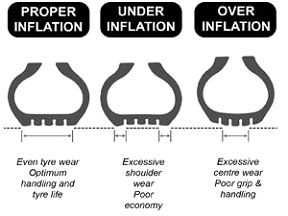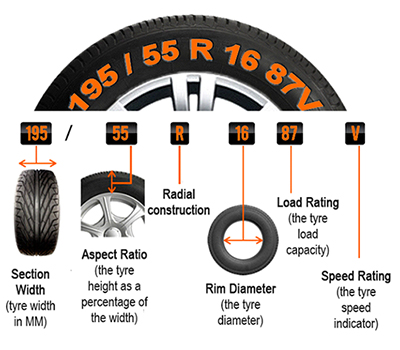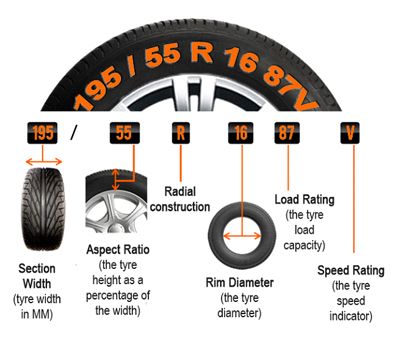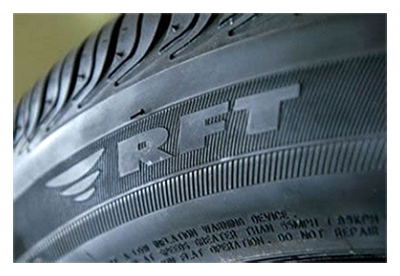Tyre Information
Tyre Info

The condition of your tyres is important for driving safety and following these tips will ensure you get the best out of your tyres including optimal fuel economy, safe performance and a longer useful life for your tyres.
Check your tyre pressures regularly.
Check your tyre pressures every 2 weeks preferably when the tyres are cold as all tyres slowly deflate over time. Low tyre pressures and different tyre pressures between tyres affects the way your car handles and drives. Incorrect tyre pressures cause uneven and premature wear of your tyres as well as add to fuel consumption if the pressure is too low. It is important to check your spare tyre pressure regularly as well.
Checking your tyre pressures regularly will also help you to identify if a tyre has a puncture and is deflating more rapidly than other tyres. Use the time you are checking your tyre pressures to visually inspect the tread and sidewalls of the tyres to see if there is any excessive wear, punctures such as nails or screws in the tyre or damaged sidewalls that may necessitate premature tyre replacement.
If you are going on long trips or carrying lots of weight regularly in your car, it is important to have your tyres inflated higher than usual. The best place to find what tyre pressure suits your car is to follow the manufacturer’s recommendations on the tyre placard on your vehicle. Most manufacturers will provide a recommendation for heavily loaded vehicles and this is a good guide for long distance travel as well.
Rotate and balance your tyres regularly.
Rotating and balancing your tyres at least every 10,000 kms will help you to maximise tyre life. Rotating between the front and rear axles is sufficient and balancing your tyres at this time will ensure that your vehicle feels smooth at higher speeds which in turn adds to longer tyre life.
Have a wheel alignment carried out regularly.
Wheel alignments are essential for good tyre wear and ensure maximum tyre contact with the road under actual driving conditions such as cornering or travelling straight, accelerating or braking. As suspension components wear, the angles that are adjusted in a wheel alignment change and can cause premature wear to your tyres. Having a wheel alignment carried out every 12 months can compensate for minor suspension wear. Wheel alignments are also a good time to have your suspension thoroughly checked as excessively worn suspension components cannot be compensated for by a wheel alignment.
Tyre Sizes

Tyre sizes are a code determined by national organisations such as the European Tyre and Rim Association. Understanding this code when purchasing your next set of tyres will help you to not only select the right tyre for your vehicle but also enable you to shop online for tyres more easily.
The tyre width or section width is measured in millimetres and is the first three digit number in the tyre size moulded into the sidewall of the tyre. It refers to the tread width from sidewall to sidewall. In the example shown it is 195 signalling the width of the tyre is 195mm.
The aspect ratio is the sidewall height as a percentage of the total width of the tyre. The two digit number after the slash in the example above is 55 and is the aspect ratio. The 55 refers to 55% of the tyre’s width of 195mm.
The construction of the tyre is represented by the letter R in the example above. This stands for radial which means the layers run radially across the tyre.
The Diameter of the rim is the size of the wheel measured from one side to the other. In the example above the rim diameter is 16 meaning it is 16 inches in diameter.
Load Index and Speed ratings

The Load Index refers to the maximum load a tyre can carry at the speed indicated by its speed rating symbol. The greater the tyre's Load Index, the greater its load carrying capacity. The Load Index rating also represents the load carrying capacity of the tyres when they are inflated to maximum psi so the load carrying capacity reduces as tyre pressures are reduced.
The speed rating is determined by laboratory tests in which the tyre is pressed against a large diameter metal drum to reflect a predetermined load and run at ever increasing speeds until the tyres required speed has been safely and constantly exceeded. Car manufacturers are required to fit tyres hat can match a car’s top speed.
In the example above, 87V represents the tyre’s load index and speed rating. In this case the tyre is rated to carry a maximum load of 545 kg at a speed of 240 kmh. While a tyre may be capable of achieving these speeds, we do not endorse driving in excess of legal speed limits.
Speed Rating Guide
| Category Symbol | Speed kmh | Category Symbol | Speed kmh |
| E | 70 | R | 170 |
| F | 80 | S | 180 |
| G | 90 | T | 190 |
| J | 100 | U | 200 |
| K | 110 | H | 210 |
| L | 120 | V | 240 |
| M | 130 | W | 270 |
| N | 140 | Y | 300 |
| P | 150 | Z | Over 240 |
| Q | 160 |
Load Index Guide
| Load Index | Kg | Load Index | Kg | Load Index | Kg | Load Index | Kg | Load Index | Kg |
| 60 | 250 | 84 | 500 | 108 | 1000 | 132 | 2000 | 156 | 4000 |
| 61 | 257 | 85 | 515 | 109 | 1030 | 133 | 2060 | 157 | 4125 |
| 62 | 265 | 86 | 530 | 110 | 1060 | 134 | 2120 | 158 | 4250 |
| 63 | 272 | 87 | 545 | 111 | 1090 | 135 | 2180 | 159 | 4375 |
| 64 | 280 | 88 | 560 | 112 | 1120 | 136 | 2240 | 160 | 4500 |
| 65 | 290 | 89 | 580 | 113 | 1150 | 137 | 2300 | 161 | 4625 |
| 66 | 300 | 90 | 600 | 114 | 1180 | 138 | 2360 | 162 | 4750 |
| 67 | 307 | 91 | 615 | 115 | 1215 | 139 | 2430 | 163 | 4875 |
| 68 | 315 | 92 | 630 | 116 | 1250 | 140 | 2500 | 164 | 5000 |
| 69 | 325 | 93 | 650 | 117 | 1285 | 141 | 2575 | 165 | 5150 |
| 70 | 335 | 94 | 670 | 118 | 1320 | 142 | 2650 | 166 | 5300 |
| 71 | 345 | 95 | 690 | 119 | 1360 | 143 | 2725 | 167 | 5450 |
| 72 | 355 | 96 | 710 | 120 | 1400 | 144 | 2800 | 168 | 5600 |
| 73 | 365 | 97 | 730 | 121 | 1450 | 145 | 2900 | 169 | 5800 |
| 74 | 375 | 98 | 750 | 122 | 1500 | 146 | 3000 | 170 | 6000 |
| 75 | 387 | 99 | 775 | 123 | 1550 | 147 | 3075 | 171 | 6150 |
| 76 | 400 | 100 | 800 | 124 | 1600 | 148 | 3150 | 172 | 6300 |
| 77 | 412 | 101 | 825 | 125 | 1650 | 149 | 3250 | 173 | 6500 |
| 78 | 425 | 102 | 850 | 126 | 1700 | 150 | 3350 | 174 | 6700 |
| 79 | 437 | 103 | 875 | 127 | 1750 | 151 | 3450 | 175 | 6900 |
| 80 | 450 | 104 | 900 | 128 | 1800 | 152 | 3550 | 176 | 7100 |
| 81 | 462 | 105 | 925 | 129 | 1850 | 153 | 3650 | 177 | 7300 |
| 82 | 475 | 106 | 950 | 130 | 1900 | 154 | 3750 | 178 | 7500 |
| 83 | 487 | 107 | 975 | 131 | 1950 | 155 | 3875 | 179 | 7750 |
Tyre Regulations and Laws

Victorian RWC regulations note that any tyre fitted to a vehicle must not have a lower load index than the original equipment tyre fitted to the vehicle as described on the tyre placard fitted to the vehicle. The tyre’s speed rating is not legally required to match the tyre placard but must meet Australian vehicle standards which state a passenger car tyre must have a minimum speed rating of S (180kmh).
The minimum tread depth must be 1.5mm at any point on the tread normally in contact with the road surface other than at tread wear indicators. Where tread wear indicators are provided the tread must not be worn to the extent that any tread wear indicator contacts the road surface.
All tyres must be free of deep cuts, cracks, bulges, exposed cords, evidence of carcass failure or separated or perished rubber. Repairs to the sidewall or shoulder areas on radial ply passenger car tyres are not acceptable. Radial ply passenger car tyres may only be repaired in the crown area. Repairs of any type are not permitted in the bead, sidewall, or shoulder area of the tyre.
The outside diameter of any tyre fitted to a passenger car must not be more than 15mm larger or 26mm smaller than any tyre designated by the vehicle manufacturer for that model of vehicle. In the case of off road passenger vehicles or a commercial vehicle, the outside rolling diameter of any tyre fitted must not be more than 50mm larger or 26mm smaller than any tyre designated by the manufacturer for that model of vehicle.
Passenger car tyres must not be 30% wider than the vehicle manufacturer’s widest optional tyre fitment and the rim width must not exceed the recommendations for the tyre fitted.
Run Flat Tyres

Some vehicle manufacturers are now using run flat tyre technology to help reduce weight and space with the elimination of the spare tyre. Run flat tyres allow the car to be driven with a punctured tyre at a reduced speed of not more than 80kmh depending on the load the car is carrying. This generally allows the driver to safely reach a service centre without stopping to change the wheel. The possible driving distances are dependent on the remaining tyre pressure - 0 PSI = approximately 150 km and 8 – 21 PSI = approximately 500km.
A mandatory requirement for the fitment of a run flat tyre is a tyre pressure monitoring system without which the driver would be unaware that the tyre had lost pressure until the tyre totally fails. The run flat tyre system relies on an electronic sensor fitted within the tyre/wheel assembly. This sensor monitors the inflation pressure within the assembly and relays the information back to the driver.
Frequently asked questions about Run Flat Tyres
Is it possible to fit a Run Flat tyre on a standard rim?
Some run flat tyre systems (usually metric rims) use a solid rubber cushioning rim prior to the fitment of the run flat tyre. Most RFT systems use a reinforced sidewall buttress construction tyre fitted onto a imperial rim known as an EH2 wheel/rim which guarantees safer retention of the tyre’s beads at zero pressure. If a standard rim is used at zero pressure the tyre will maintain its run flat characteristics as long as the beads do not drop into the rim well. A tyre pressure monitoring system must always be used with any conversion to run flat tyres.
Can standard tyres be used instead of run flat tyres?
Yes standard tyres can be fitted but all benefits of a run flat tyre will be lost and if no spare comes with the vehicle then there is high chance of being stranded with a flat tyre.
Can I mix standard and run flat tyres?
It is recommended that all four tyres fitted to the car are of the same brand. It is possible to mix different tyres but it is strongly recommend that the same type of tyre is fitted to the same axle.
Can a punctured run flat tyre be replaced with a standard tyre?
Some manufacturers do not recommend the mixing of tyres on the same axle. In an emergency situation it is possible to fit a standard tyre as a temporary measure and driving distances and speeds should be minimised. The standard tyre must be replaced with a run flat tyre ASAP.
Can I mix one brand of run flat tyres with another brand of run flat tyres?
Yes it is possible to mix brands of tyres although most tyre manufacturers strongly recommend that run flat tyres be fitted in sets of four and never mix them with another brand.

